Crear una página de archivos personalizada en WordPress puede mejorar significativamente la navegación de su sitio y la capacidad de descubrir contenidos.
En WPBeginner, hemos implementado nuestra propia página de archivos personalizada para ayudar a los lectores a acceder fácilmente a nuestra amplia colección de entradas de blog y tutoriales.
Una página de archivos bien diseñada puede mejorar la experiencia del usuario, impulsar la participación e incluso ayudar al SEO al proporcionar una estructura de sitio vaciada. Es útil para sitios con mucho contenido, blogs y revistas en línea en los que los visitantes quieran profundizar en debates específicos.
En este artículo, le mostraremos cómo puede crear una página de archivos personalizada en WordPress.
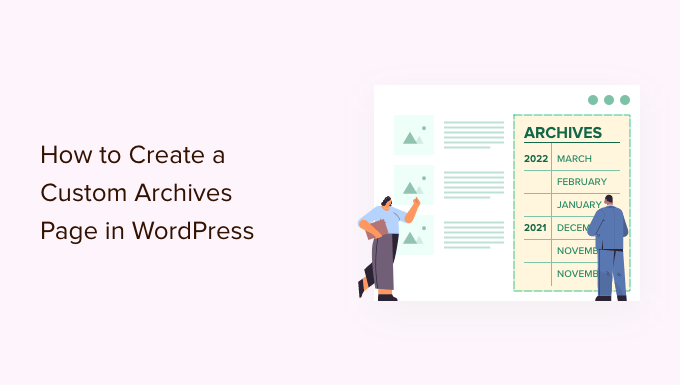
¿Por qué crear una página de archivos personalizada en WordPress?
El objetivo de una página de archivos es mostrar una lista cronológica de sus entradas anteriores, facilitando a los visitantes la exploración de su contenido en función de las fechas de publicación.
Si eres bloguero, tener una página de archivos es imprescindible. Permite a los usuarios acceder a entradas antiguas sin tener que desplazarse por todo el blog.
Es posible que desee crear una página de archivos personalizados si su tema actual no tiene una plantilla de página de archivos en su lugar. Incluso si la tiene, es posible que quieras personalizarla según tus necesidades.
En WPBeginner, utilizamos una página de archivos personalizada que cuenta con un botón que lleva a los usuarios a nuestra colección de guías WPBeginner. De esta manera, los nuevos lectores pueden simplemente hacer clic en él para ver nuestros últimos recursos de guías.
También organizamos todas las entradas de nuestro blog en años y meses para que los lectores puedan ver fácilmente qué artículos se publican en un periodo determinado.
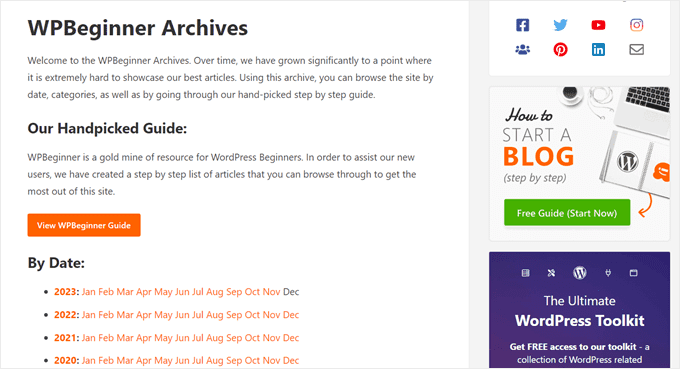
Aquí también hemos añadido las categorías y etiquetas de nuestro sitio a la página de archivo personalizada.
De este modo, los visitantes pueden encontrar fácilmente entradas antiguas que puedan interesarles. Si haces esto para tu propio blog, tendrás más posibilidades de aumentar las páginas vistas y reducir la tasa de rebote.

Con esto en mente, veamos cómo puede crear una página de archivos personalizada en WordPress, independientemente del tema que esté utilizando.
Utilice los enlaces rápidos que aparecen a continuación para acceder directamente al método que desee utilizar.
Método 1: Crear una plantilla de archivos personalizada con el editor de bloques (sin plugins)
Si utiliza un tema en bloque, el editor de sitios completo facilita el diseño de una plantilla de página de archivos personalizada.
Este método no funciona con todos los temas, así que si no utilizas un tema de WordPress basado en bloques, te recomendamos que utilices un maquetador de páginas.
Para empezar, basta con crear una nueva página o abrir una página existente que desee utilizar como archivo. En el menú de la derecha, haga clic en la pestaña “Página” y, a continuación, seleccione el enlace situado junto a “Plantilla”. El texto exacto del enlace puede variar en función de la plantilla que estés utilizando.
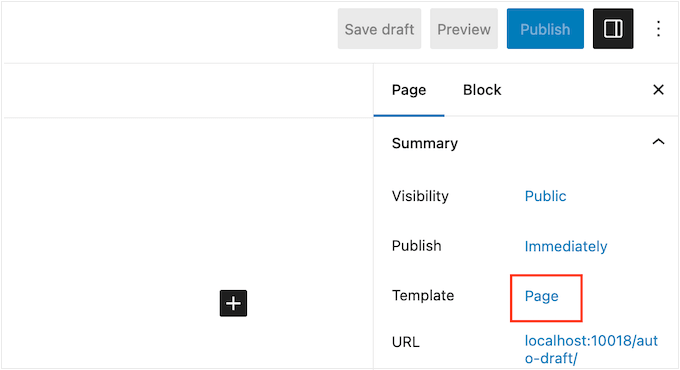
Ahora aparecerá una ventana emergente con su plantilla actual.
Sólo tiene que seguir adelante y hacer clic en el icono “Nueva plantilla”.
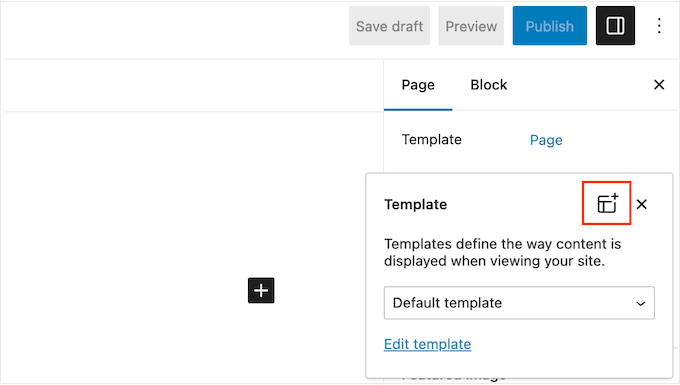
En la ventana emergente, escriba un nombre para la plantilla de página personalizada. El nombre de la plantilla es sólo para su referencia, por lo que puede utilizar cualquier cosa que desee.
A continuación, haz clic en “Crear” para iniciar el editor de plantillas.
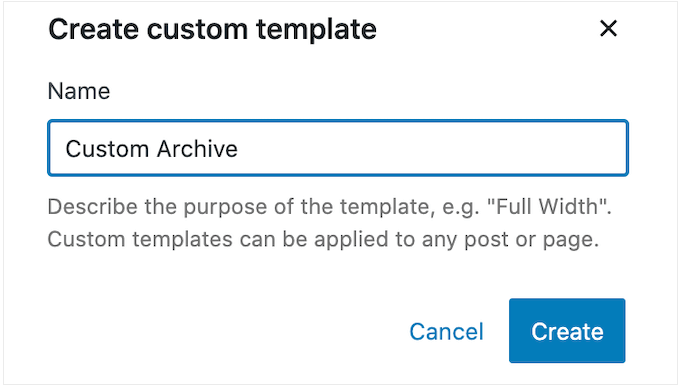
El editor de plantillas funciona de forma similar al editor de bloques estándar de WordPress.
Para añadir bloques a su página de archivos personalizada, sólo tiene que hacer clic en el botón azul “+”. A continuación, puede arrastrar y soltar para añadir bloques a su estructura / disposición / diseño / plantilla.
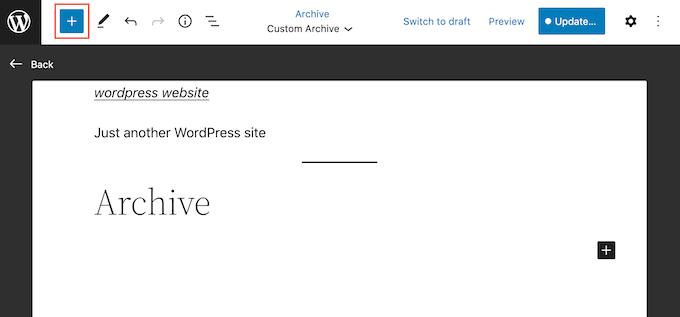
Como estamos creando una página de archivos personalizada, normalmente querrás empezar añadiendo un bloque de Archivos. Este bloque de WordPress permite a los visitantes explorar tus entradas en función del año, mes, semana o día.
Por ejemplo, la siguiente imagen muestra un bloque Archivos en el que las entradas se organizan en archivos mensuales.
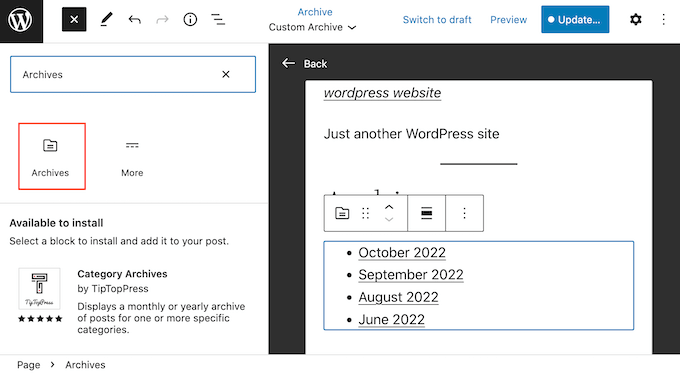
Al hacer clic en cualquiera de estos enlaces, el visitante accederá a una nueva página en la que se mostrarán todas las entradas publicadas durante ese periodo.
Para añadir un bloque de Archivos, búscalo en el menú de la izquierda y arrástralo a tu estructura / disposición / diseño / plantilla. Después de añadir un bloque, te recomendamos que consultes sus ajustes en el menú de la derecha.
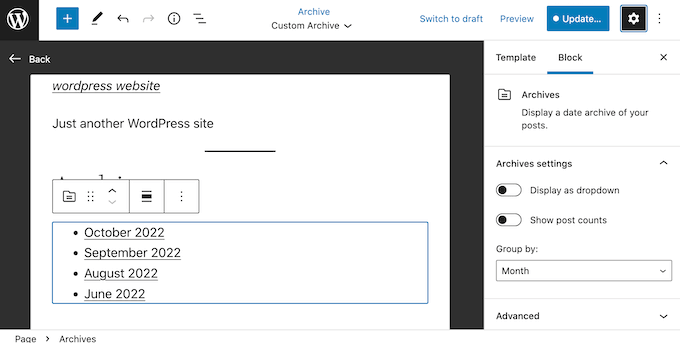
Para empezar, puede cambiar la organización de las entradas abriendo el menú desplegable “Agrupar por” y eligiendo una opción de la lista.
Por ejemplo, si solo tiene un pequeño número de entradas, puede tener sentido mostrarlas por días.
Sin embargo, si tiene mucho contenido, normalmente querrá elegir “Mes” o incluso “Año” para no abrumar a los visitantes con un largo anuncio / catálogo / ficha.
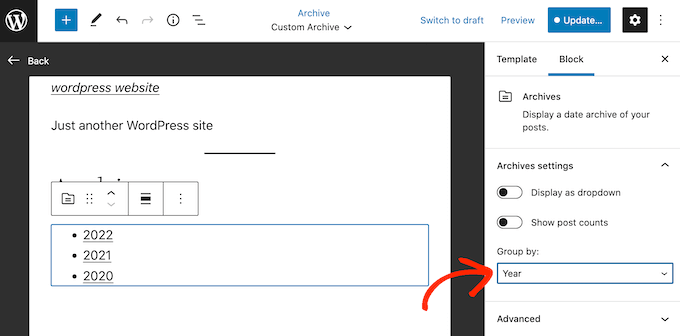
WordPress muestra por defecto las entradas archivadas en una lista con viñetas, pero también puede presentarlas como un menú desplegable.
Esto puede ser útil si tienes muy poco espacio y necesitas crear un archivo compacto. Para cambiar al formato desplegable, basta con hacer clic en el carrusel / control deslizante “Mostrar como desplegable” para activarlo.
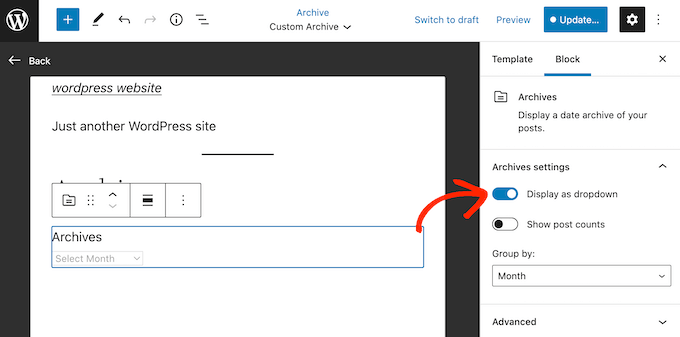
El bloque Archivo también puede mostrar el número total de entradas junto a cada encabezado.
Esto puede ayudar a los visitantes a decidir qué parte del archivo quieren ver primero.
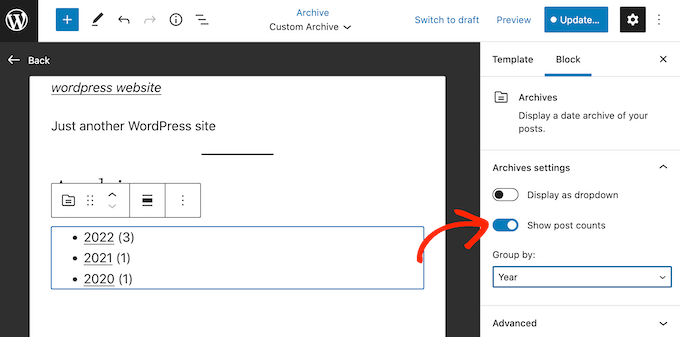
También puede añadir un archivo de categorías para que los visitantes puedan explorar sus entradas en función de su contenido y no sólo de la fecha. Esto puede ayudar a los visitantes a encontrar contenido interesante, lo que les mantendrá en tu sitio web durante más tiempo y mejorará tu SEO en WordPress.
Para añadir este bloque, basta con hacer clic en el botón azul “+” y escribir “Lista de categorías”. Cuando aparezca el bloque adecuado, añádelo a tu estructura / disposición / diseño / plantilla arrastrando y soltando.
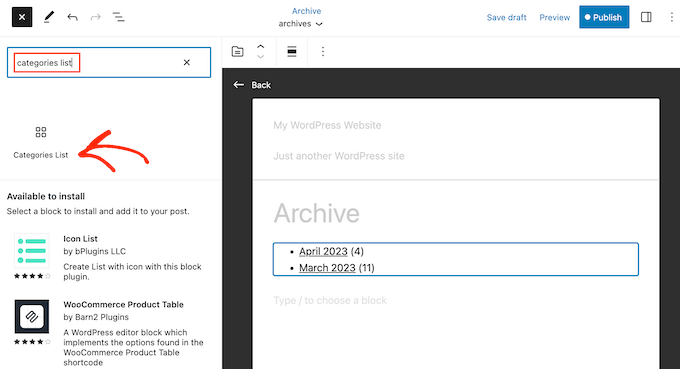
Una vez más, es posible que desee realizar algunos ajustes en la configuración del bloque.
Al igual que en el bloque Archivos, puede añadir un recuento de entradas a la lista o mostrar las categorías como un menú desplegable en lugar de una lista con viñetas.
Por defecto, este bloque muestra todas las categorías y subcategorías exactamente de la misma manera.
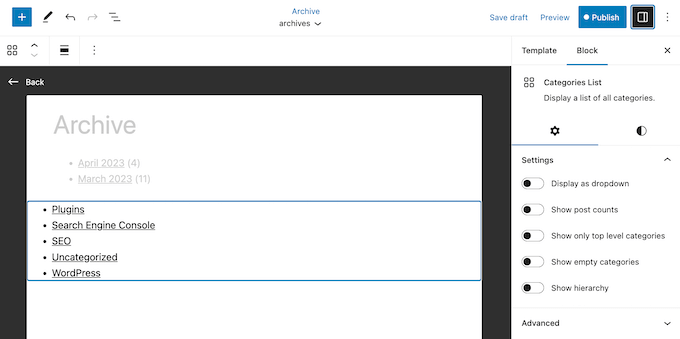
Es posible que prefiera mostrar las categorías secundarias con sangría debajo de su categoría principal.
Para realizar este cambio, basta con hacer clic para activar el conmutador “Mostrar jerarquía”.
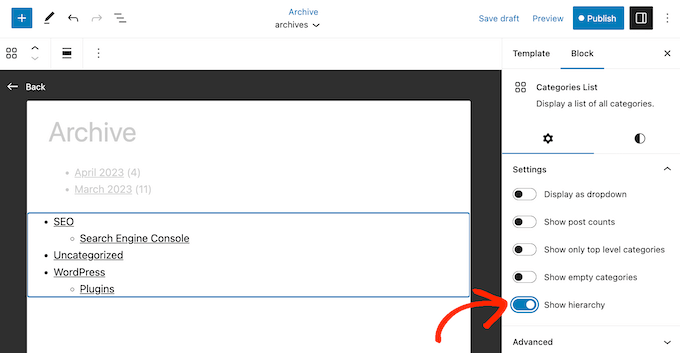
Otra opción es ocultar completamente las categorías inferiores activando el conmutador “Mostrar solo las categorías de nivel superior”.
También puede añadir una nube de etiquetas, que puede ayudar a los visitantes a encontrar contenidos interesantes relacionados. Para ello, busque “Nube de etiquetas” en el menú de la izquierda y arrástrela a la estructura / disposición / diseño / plantilla.
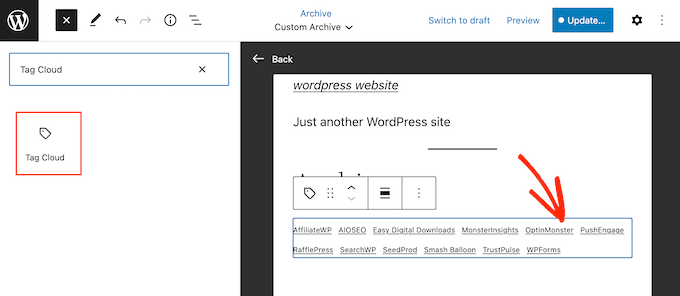
Ahora puede seleccionar el bloque y configurarlo mediante los ajustes del menú de la derecha.
Para empezar, la Nube de etiquetas tiene dos estilos: Por defecto y Contorno. Puede cambiar de uno a otro haciendo clic en el icono del círculo pequeño y eligiendo una de las opciones de “Estilos”.
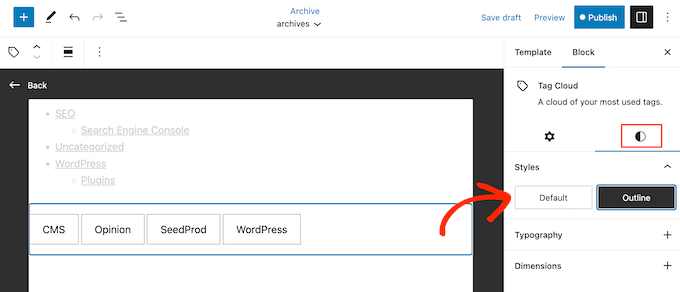
También puede utilizar mostrar el número total de entradas a continuación de cada etiqueta, y cambiar el número de etiquetas que se incluyen en la nube.
Basta con hacer clic en el pequeño icono de engranaje y realizar los cambios en esta sección.
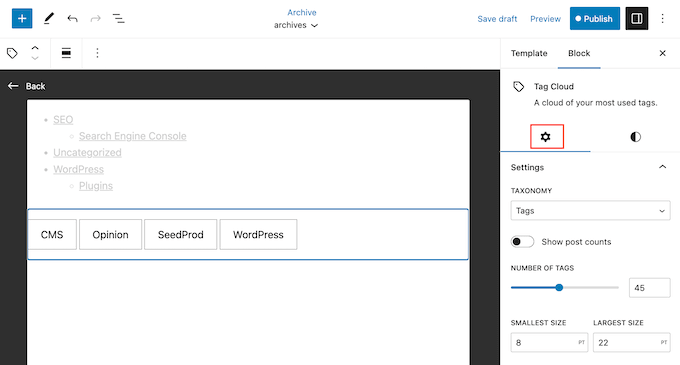
A pesar del nombre, también puede mostrar categorías en la Nube de etiquetas. Por ejemplo, puede que prefiera el estilo del bloque Nube de etiquetas en comparación con el bloque Categorías.
Para mostrar las categorías de su sitio, abra el menú desplegable “Taxonomía” y seleccione “Categorías”.
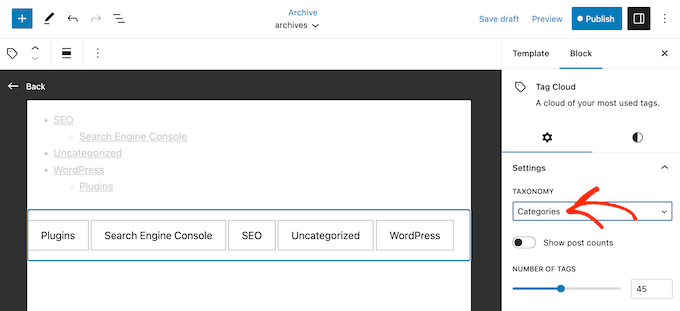
Los archivos están diseñados para facilitar a los visitantes el acceso a todo su contenido.
Sin embargo, también puede destacar las entradas más recientes de su sitio añadiendo un bloque de Últimas entradas.
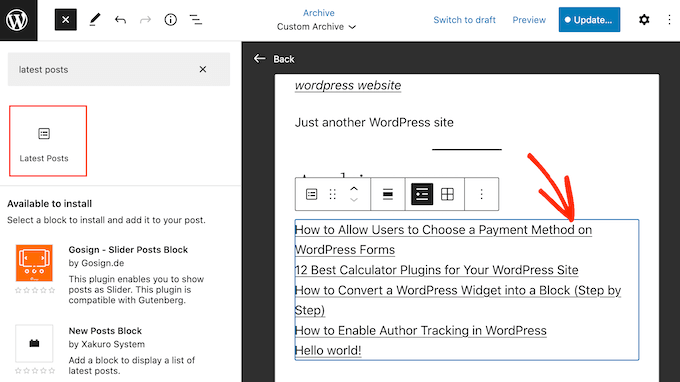
Por defecto, este bloque muestra simplemente el título de cada entrada, pero puede añadir el autor, la fecha de publicación y la imagen destacada.
Sólo tiene que utilizar los conmutadores del menú de la derecha para realizar estos cambios.
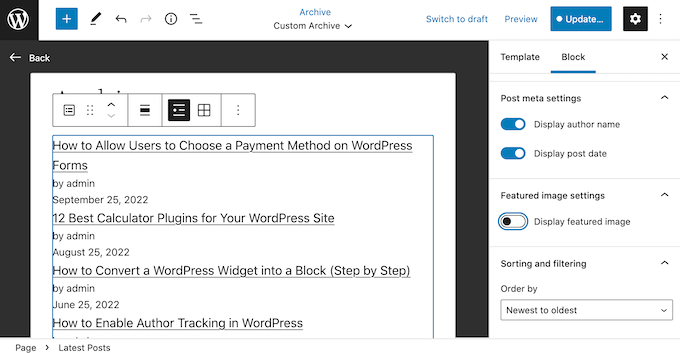
También puede mostrar el extracto de la entrada, que puede ayudar a los visitantes a entender de qué trata cada entrada.
Para añadir los extractos, siga adelante y haga clic para activar el conmutador “Contenido de la entrada”.
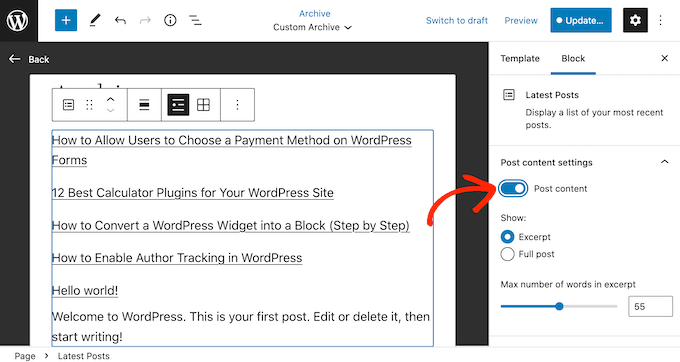
A continuación, haga clic para seleccionar el botón “Extracto”.
Por defecto, WordPress mostrará un máximo de 55 palabras en el extracto. Para mostrar más o menos palabras, simplemente utilice los ajustes de ‘Número máximo de palabras en el extracto’.
Una vez hecho esto, desplácese hasta la sección “Clasificación y filtrado”.
Aquí puede ver que el bloque organiza las entradas de la más reciente a la más antigua. Puede cambiarlo abriendo el menú desplegable “Orden” y eligiendo una opción diferente, como “A-Z”.
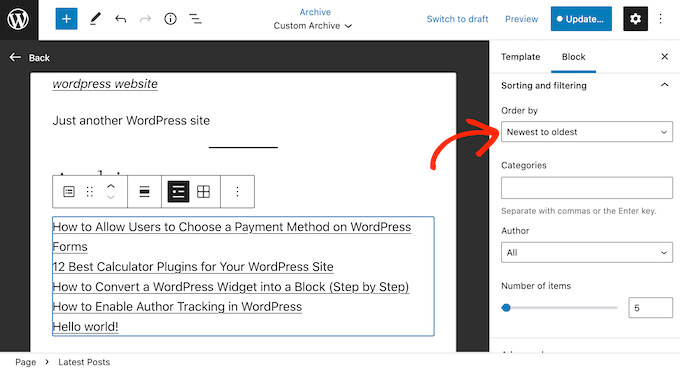
En esta sección, también puede elegir mostrar entradas de un autor o categoría en particular.
Por último, puede cambiar el número de entradas que WordPress muestra en el bloque, ya sea escribiendo un nuevo número en la sección “Número de elementos” o arrastrando el carrusel / control deslizante.
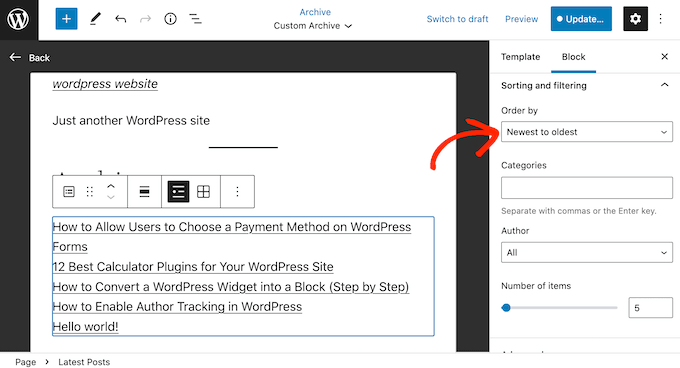
Puede seguir trabajando en su página de archivo añadiendo más bloques y configurándolos en el menú de la derecha.
Por ejemplo, puede que desee añadir un bloque de imagen y mostrar un logotipo personalizado o añadir una barra de búsqueda para que los visitantes puedan buscar una entrada concreta.
Cuando estés satisfecho con el aspecto de la plantilla, haz clic en el botón “Publicar” y, a continuación, en el botón “Guardar”.
La página que creó anteriormente utilizará ahora la nueva plantilla de archivo. Puede actualizar o publicar la página y, a continuación, visitar su sitio web de WordPress para ver la página de archivo personalizada en directo.
Para más información acerca de cómo utilizar el editor de sitios completo de WordPress, compruebe las siguientes guías:
- Guía completa para principiantes sobre la edición completa del sitio de WordPress
- Guía para principiantes: Cómo utilizar los patrones de bloques de WordPress
Método 2: Crear una Página de Archivo de WordPress Personalizada Usando Seedprod (Recomendado)
El editor basado en bloques te permite crear una sencilla página de archivos personalizada. Sin embargo, no funciona con todos los temas, y estás limitado a los bloques y herramientas integrados en WordPress.
Si desea crear una página de archivos completamente personalizada que funcione con cualquier tema de WordPress, le recomendamos que utilice un maquetador de páginas.
SeedProd es el mejor editor de arrastrar y soltar páginas para WordPress. Viene con más de 180 plantillas y bloques listos, incluyendo un bloque que muestra todas las entradas de su sitio web.
Primero, necesitas instalar y activar SeedProd. Para más detalles, consulte nuestra guía paso a paso sobre cómo instalar un plugin de WordPress.
Nota: Hay una versión gratuita de SeedProd que le permite crear páginas personalizadas si usted está en un presupuesto ajustado y acaba de empezar. Sin embargo, para esta guía, vamos a utilizar SeedProd Pro ya que tiene muchas más plantillas y bloques.
Después de activar el plugin, SeedProd le pedirá su clave de licencia.

Encontrará esta información en su cuenta del sitio web de SeedProd. Después de introducir la clave, haga clic en el botón “Verificar clave”.
Una vez hecho esto, vaya a SeedProd ” Páginas de destino y haga clic en el botón “Añadir nueva página de destino”.
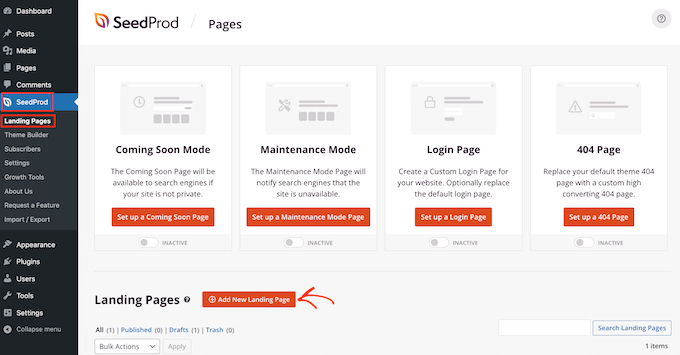
Ahora puede elegir una plantilla para la página de archivos personalizada.
Las plantillas de SeedProd están organizadas en diferentes tipos de campaña como captación de clientes potenciales, modo mantenimiento y próximamente. Puede hacer clic en las pestañas de la parte superior de la pantalla para filtrar los diseños en función del tipo de campaña.
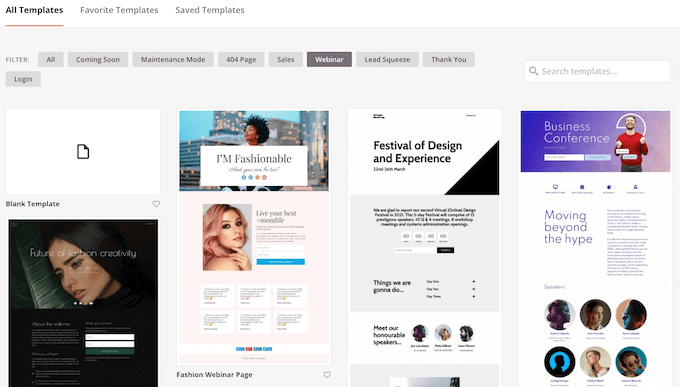
Para obtener una vista previa de cualquier diseño, basta con pasar el cursor por encima de esa plantilla.
A continuación, haga clic en el icono de la lupa que aparece.
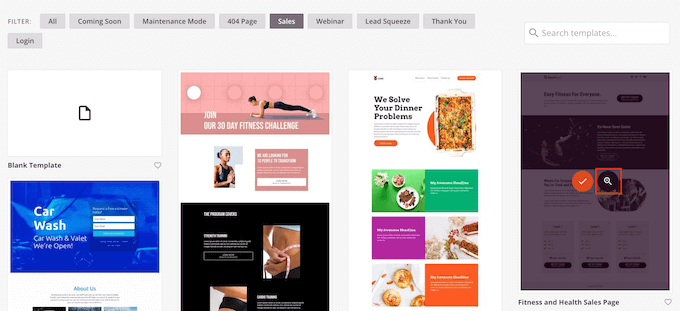
Cuando encuentres un diseño que te guste, haz clic en ‘Elegir esta plantilla’. Nosotros utilizamos la “Plantilla en blanco” para empezar de cero, pero usted puede utilizar la plantilla que desee.
A continuación, escriba un nombre para la página personalizada. SeedProd creará automáticamente una URL basada en el título de la página, pero puede cambiar esta URL si lo desea.
Cuando esté satisfecho con la información que ha introducido, haga clic en el botón “Guardar y empezar a editar la página”.
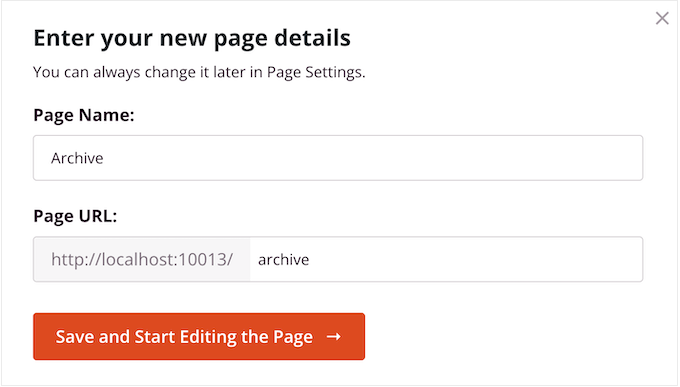
Esto cargará la interfaz del maquetador de páginas SeedProd. Es un simple editor de arrastrar y soltar que muestra una vista previa en vivo de su página a la derecha.
También verás ajustes de bloque a la izquierda.
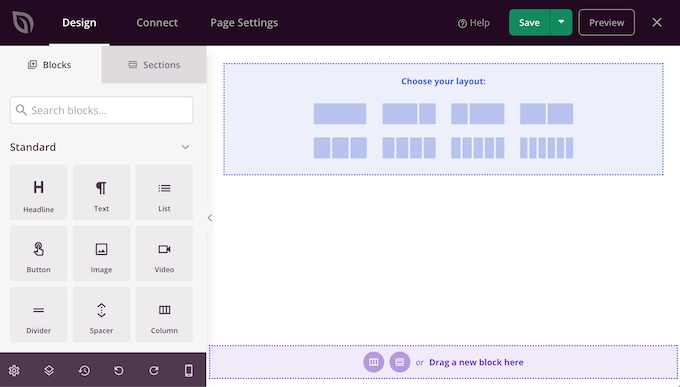
Para empezar, tendrá que elegir una estructura / disposición / diseño / plantilla, que organizará su contenido en columnas.
En la sección “Elige tu disposición”, sólo tienes que hacer clic en la disposición que quieras utilizar. Puede elegir cualquier disposición, pero nosotros utilizamos la de pantalla completa en todas nuestras imágenes.
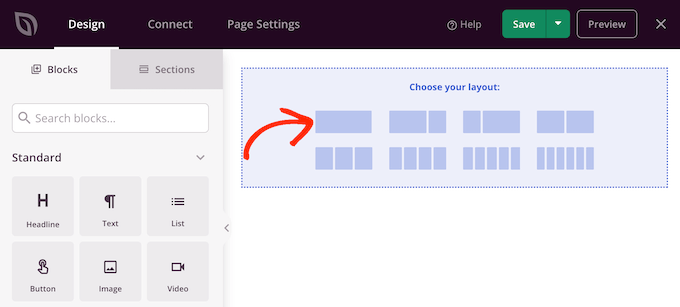
Después de elegir una estructura / disposición / diseño / plantilla, puede empezar a añadir bloques a la página de archivos.
El menú de la izquierda muestra los diferentes bloques que puedes arrastrar a tu diseño. Como estamos creando una página de archivo personalizada, vamos a añadir un bloque Entradas.
En el menú de la izquierda, escribe “Entradas” en la barra de búsqueda. Cuando aparezca el bloque adecuado, arrástralo y suéltalo en tu estructura / disposición / diseño / plantilla.
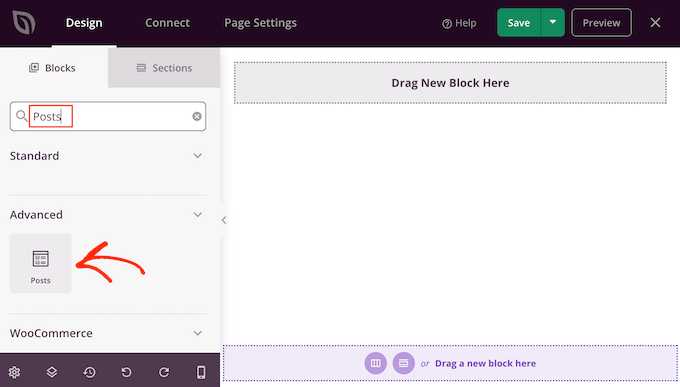
Este bloque mostrará el título de todas tus entradas.
También tiene un enlace “Seguir leyendo” en el que los visitantes pueden hacer clic para leer cada entrada en su totalidad.
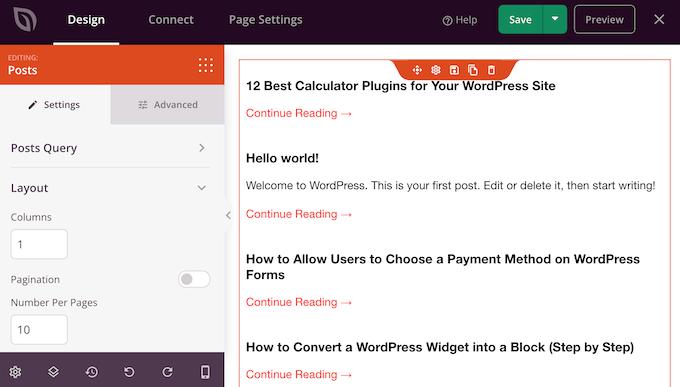
Por defecto, este bloque muestra todas tus entradas, pero puedes cambiarlo para que solo muestre entradas que tengan una categoría o etiqueta concreta, o entradas publicadas por un autor específico.
Para realizar este cambio, simplemente haz clic para seleccionar el bloque “Entradas” en tu disposición y luego utiliza los ajustes del menú de la izquierda.
Por ejemplo, en la siguiente imagen, solo se muestran entradas de la categoría “Marketing”.
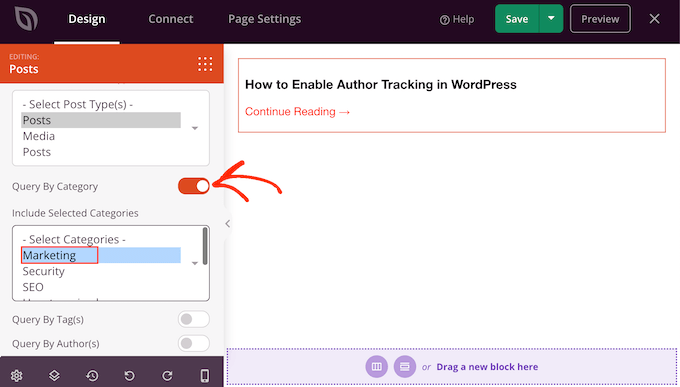
También puedes cambiar cómo se organizan las entradas en el bloque. Por ejemplo, puede mostrar entradas en función de cuándo se publicaron o cuántos comentarios tienen.
Para cambiar el orden de sus entradas, simplemente desplácese hasta la casilla ‘Ordenar por’ y elija una nueva opción. Por defecto, SeedProd muestra las entradas en orden ‘ASC’, que significa ascendente.
Para ordenar las entradas en orden descendente, basta con abrir el menú desplegable “Orden” y seleccionar “DESC”.
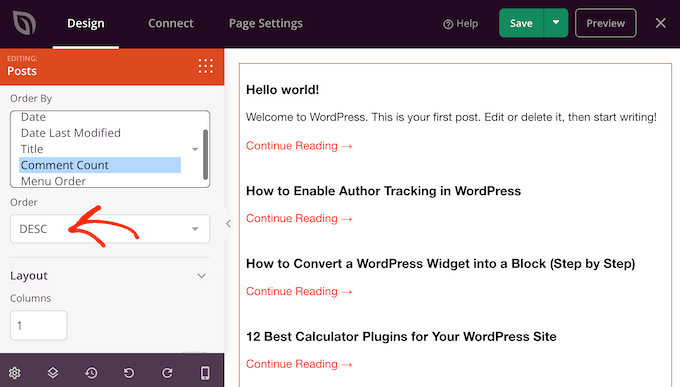
A continuación, puede desplazarse hasta la sección “Disposición” y cambiar la forma en que se muestra la lista de entradas.
Por ejemplo, puede dividir las entradas en varias columnas escribiendo un nuevo número en el campo “Columnas”.
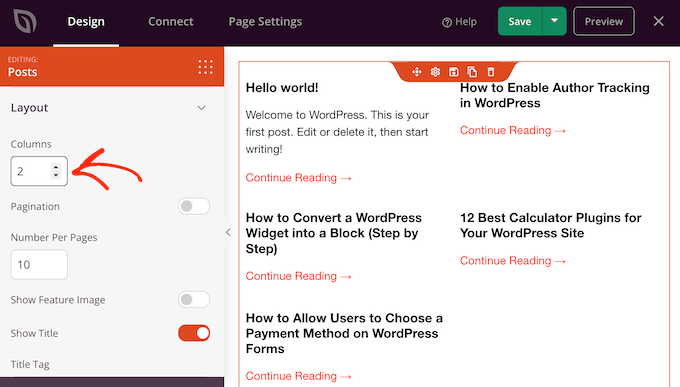
También puede cambiar el número de entradas incluidas en la lista, añadir u ocultar los extractos de entradas y cambiar el texto “Seguir leyendo”.
Cuando esté satisfecho con el aspecto de la lista de entradas, puede añadir más bloques a la página de archivos y personalizarlos con los ajustes del menú de la izquierda.
Por ejemplo, puede animar a la gente a seguirle en los medios sociales añadiendo un bloque de “Perfiles sociales”.
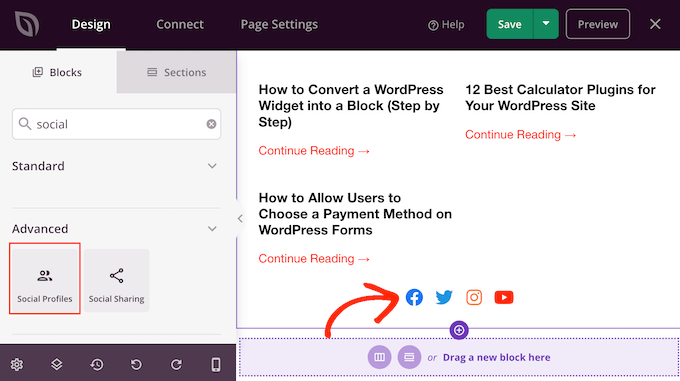
Cuando esté satisfecho con cómo se ha establecido la página, es hora de publicarla, para lo que debe hacer clic en la flecha desplegable situada junto a “Guardar” y, a continuación, seleccionar “Publicar”.
Su página de inicio personalizada aparecerá en la portada de su blog de WordPress.
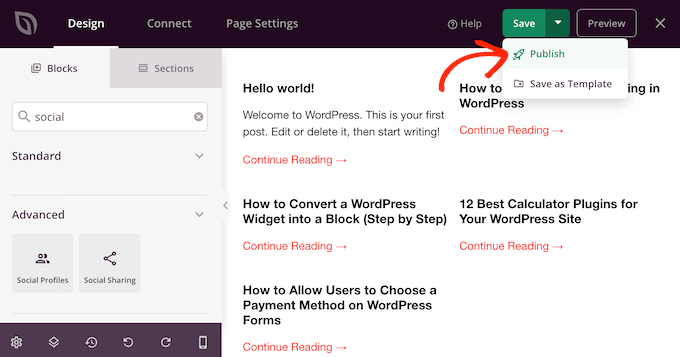
Para ayudar a los visitantes a encontrar la página de archivo, puede añadirla al menú de navegación o al pie de página de su sitio web.
Más formas de organizar tus entradas en WordPress
Crear una página de archivos personalizada es sólo una forma de organizar el contenido de WordPress. Aquí tienes algunos métodos adicionales para ayudar a tus lectores a descubrir y navegar por tus entradas de forma más eficaz:
- Mostrar entradas populares – Destaca tu contenido más leído con los plugins de entradas populares. Marcar / comprobar nuestra comparación de los mejores plugins de entradas populares para WordPress para encontrar la solución adecuada para su sitio.
- Mostrar entradas por visitas – Aprende a mostrar entradas populares por visitas en WordPress utilizando diferentes métodos. Esto puede ayudar a llamar la atención sobre su contenido más atractivo.
- Entradas destacadasen la barra lateral – Explore diferentes métodos para añadir entradas destacadas en la barra lateral de WordPress. Es una buena forma de promocionar contenidos específicos o artículos recientes.
- Crear archivos de tipo de contenido personalizado – Si utiliza tipos de entradas personalizados, puede aprender a crear una página de archivo de tipos de contenido personalizado en WordPress para organizar este contenido especializado.
- Mostrar entradas relacionadas – Aumenta la participación de los lectores mostrando contenido relacionado. Nuestra guía práctica sobre cómo mostrar entradas relacionadas en WordPress le mostrará cómo hacerlo.
- Destaque las entradas más coment adas – Muestre su contenido más comentado con nuestro tutorial sobre cómo mostrar las entradas más comentadas en WordPress utilizando dos métodos diferentes.
- Reordenar entradas – Controla el orden de tus entradas con nuestra guía sobre cómo reordenar entradas fácilmente en WordPress. Esto puede ser particularmente útil para crear listas o series seleccionadas.
- Mostrar entradas del mismo autor – Anime a los lectores a explorar más contenido de escritores específicos con nuestra guía práctica sobre cómo mostrar entradas relacionadas del mismo autor en WordPress.
Esperamos que este artículo te haya ayudado a crear una página de archivos personalizada en WordPress. Puede que también quieras leer nuestro artículo sobre los mejores ejemplos de páginas próximamente disponibles y nuestra selección de los mejores plugins de entradas relacionadas para WordPress.
If you liked this article, then please subscribe to our YouTube Channel for WordPress video tutorials. You can also find us on Twitter and Facebook.




Martin
Great article.
I have maybe a silly question. Is there any SEO benefit if I have a custom archive page or even archive.php. in the theme folder?
Or is it the same as creating a new page with url mydomain/archive and listing all my posts and pages based on the categories I want. This is what I would prefer.
Thank you
WPBeginner Support
Having a custom archive would not give an SEO benefit, it would be personal preference and you can use your second method if you wanted.
Admin
Aileen
Hi–my site is using the Genesis framework an it has a child theme. I tried to implement the page-archive.php, but I skipped the part where I copy the page design from page.php and I’d hope it would work regardless.
So when I tried implementing this, when I go to my Archive place, it gives an Internal error, ie. 505 and cannot find the page itself.
How does this work with Genesis?
WPBeginner Support
Adding a custom page template would be the same as with any other theme, it seems like there may be a problem with the code you’re using to create the archive page.
Admin
Rahul Lakra
Firstly, Thank you so much. But I can’t see any sidebar in this page. In normal pages it is visible. I will be so happy if you can help me out to display sidebar here too. Thanks In advance!
WPBeginner Support
For the sidebar, sadly that is theme specific for what needs to be added, if you reach out to your theme’s support they should be able to let you know how they have the sidebars added to the templates.
Admin
Vijay Sundaram
Hi,
This was a great tutorial. However, the CSS code for the categories does not seem to work. It is shown as a list with categories and subcategories. Where do I embed the code that you have given in the style.css file? What is meant by make it appear inline? It would be great if you could help me resolve this?
Regards,
Vijay Sundaram
John Paul
Is it possible to filter the archive to just one category of a post?
Woolker Cherenfant
Thank you for this helpful tutorial. I do follow along and have my custom archive page up. However, I still get the default WP archive under my custom settings. Could you please have a look and tell me what have I done wrong?
Thanks for your kind reply.
—Woolker Cherenfant
Woolker Cherenfant
Never mind. I got it solved. Thanks.
—Woolker Cherenfant
WPBeginner Support
Hi Woolker Cherenfant,
Unfortunately, its hard for us to detect any mistakes. We will recommend you to try the tutorial again and see if this helps.
Admin
Neil
I wonder if anyone can help?
hopefully someone might be able to help with an unusual problem that I have noticed – and it appears to have been occurring since Nov 2017 or before…
For example…
this url has been generated/created and I don’t know how or why… it seems that with two categories if I take a ‘whole’ url and copy and paste that after the category part only url then it will resolve… (and has been indexed!)
ie
I think this has only happened with (archive) pages…
To make matters worse these urls have been indexed by Google. I don’t know if a plugin has caused this or something else…
Note the single ‘/’ in the second part of the url…
WPBeginner Support
Hi Neil,
Please see WordPress troubleshooting tips to figure out what caused this issue.
Admin
Subhash
Dear Sir,
How to customize the look of default archive page. I want to add 2 sidebars instead of 1 sidebar. I am talking about this page https://www.wpbeginner.com/2017/06/
Thanks
WPBeginner Support
Hi Subhash,
For that you’ll need to edit your theme’s date.php or archive.php template files and call your sidebars in the template file.
Admin
Subhash
Hi Support Team,
Thanks for guidance about this.
Have a good day!
Regards
Subhash
Nyx
Wonderful tutorial! Thanks so much.
Quick, I hope, question: I used your instructions for adding “Adding a List of all Categories.” How can I get my list itself to show justified inside the space, instead of left aligned. Thanks for any help.
Dave Ward
This worked great, but I want to display an actual snippet of the archived pages instead of just a list. Is there a way to do that?
Mohammad Kharoofa
Thanks for this useful article, I have one problem Add code to my theme’s style.css file, Where should I paste it exactly ? because I’ve tried to paste anywhere but nothing change!
Emma
Can this be done with a free WordPress account, or do you need the customising options of one of the paid plans?
Thanks if you can let me know
WPBeginner Support
Hi Emma,
Please see our guide on the difference between self hosted WordPress.org vs free WordPress.com blog.
Admin
Andry
Hi !
I’m preparing a news site with WP theme but I have a GREAT question about archives, maybe you’d be able to give me your opinion thanks to your experience.
The site must give a new version everyday (relating to the paper edition) and offer an archive page which allows to find the old editions as it was published the day ‘d’. Plugins in WP allow only to have articles by date, so we have a list of the old artilces for a specific date but not the whole edition (a complete copy of the site as it was published at a ‘d’ date). Do you know any plugin for WP to ‘make a copy’ of a site so it’d be possible to link every ‘copy-date’ with a date in the calendar table? or an archive plugin to have automaticly the old editions ? Is it possible to have a folder (in the WP repertory) which contains all the articles of an edition ? so I can link each folder to a date in my calendar table ?
– Do you have in your favorite lists a good WP theme for newspaper ?
Thanks in advance !
Aaliya Thahseen
Upload the page-archive.php in your WordPress themes folder, and you have created an Archives page template.
I am having difficulty with this part. How do I upload the page-archive,php in the wordpress themes folder?
WPBeginner Support
You can do that using an FTP Client. Your WordPress hosting provider will provide you login details.
Once connected to your site using FTP, you need to visit /wp-content/themes/ folder. There you need to open your theme folder and upload the file from your computer. See our guide on how to use FTP to upload files to WordPress.
Admin
Cely
Hello, I’ve been done the steps of uploading the php on the theme folder. then I went back to my wordpress, the templave “archives” is still not there. could you please help me.
dwieyoko
how to create search form and display search result on archive.php.. ?
Kyran Wallace
Hi there
This worked great for me! Thank you.
One thing though, My list of archives will not show on mobile devices. I am currently running the WPTouch plugin for mobile users.
Could you advise how to resolve this please?
Thanks
Pete
Hi, is there a way just to list certain categories i.e. exclude some categories from the list?
Thank you.
WPBeginner Support
yes you can use wp_list_categories function like this.
<ul><?php wp_list_categories('exclude=4,7&title_li='); ?></ul>1-click Use in WordPress
Replace 4,7 with the IDs of categories you want to remove.
Admin
loic
Hello,
I have registered different CPT.
I have created a page template which list posts for a given CPT.
I have put a query (query_posts(‘posts_per_page=-1&post_type=my_cpt_one’); before the loop.
Than I have selected the page template when creating the page archive of the given CPT.
How to use the same page template for each CPT?
For example, I want three page archive named “my cpt one”, ‘my cpt two”, “my cpt three” which calls the same page template.
Of course, i could use three page templates, but I’m looking for a way to use only one page template.
My problem is to set in the query the post type slug.
Is that possible?
Cheers.
Avdhesh Arya
Thanks so much! This has helped a lot in creating a custom Archives page for my website.
WPBeginner Staff
That’s because template tag wp_list_categories generates a bulleted list of your categories by default. Child categories are displayed indented under their parent categories. You can use
<?php wp_list_categories('title_li=&style=none'); ?>to display your categories with line breaks.Cara Zimmerman Seekell
My categories look sort of all over the place, any idea why?
yasinatagun
Cant we make it without plugin? I just want to list my all of posts in one page. No matter there is 10000 posts or 2 post. i just want to list ?
Luca
I would like to create an yearly/monthly archive of a specific category. Is it possible using with a filter for a specific category?
April
I am looking high and low for my themes folder… I know a
little more than basic for coding, but working with WordPress has been
difficult for me trying to find everything. Maybe it is not compatible with
what I have.
I am trying to have a page on my blog for a list of Archived
blog posts that looks like this: https://www.wpbeginner.com/archives/ with year,
month, and categories. I have a lot of posts. I tried the plugin http://wordpress.org/plugins/archives/
for Archives and created a page and added [archives] and all I got was a whole
list of all my blog post titles. It was long.
I found this post https://www.wpbeginner.com/wp-tutorials/how-to-create-an-archives-page-in-wordpress/
but I cannot locate a themes folder in wordpress. Maybe I have the wrong set
up?
I am hosted with one of the outside WordPress recommended
hosts using WordPress for my blog. My theme is Twenty Ten.
If someone could help me get the result I am looking for,
that would help me a lot. Thanks!
Essekia Paul
If anyone is looking for an answer to this. The path is :
WordPress root folder -> wp-content -> themes -> Twenty Ten
Member At Blc
I have added the archive page to my site but I only want to see the date / categories and archives in the members only section Is this possible?
Member At Blc
I have just added archive page to my site but want the posting pages, dates and categories hidden and only visible when you log in. My post pages currently show blocked but I see them in public view. Can these be hidden???
Avinash
Works Perfectly, When I tried to add &show_count=1 then the count breaks the category listing .. can you help with the css needed for the count to display properly.
Pawan Kesari
Very helpful. I have just added archive page to my blog site
Question: Would this template file get deleted during theme upgrade?
WPBeginner Support
Yes it will, it would be better to create the template file in a child theme.
Admin
Charlie
Nice howto, but is there any way to manage something like this in a plugin?
Nicole
I love this tutorial! However, I want my tag cloud to be separated by commas. Here’s the code I used for the tag cloud (I don’t want the font sizes to change so I kept the smallest and largest at the same size)…
Tags
Any tips?
WPBeginner Support
Your code was stripped by WordPress comments. This snippet should work:
<?php$args=array('smallest'=> 8,'largest'=> 22,'separator'=>',');wp_tag_cloud($args);?>1-click Use in WordPress
Admin
voltima
Thanks a lot for a very easy to understand ‘how-to’.
Thomas
Hi, thanks for the great tutorial!
I did set-up the list of all categories which looks perfect. The only problem I have is that if I add any content to that page, the list of all categories is always placed at the bottom. Is there a way how I can set it to the top of the page?
Archurst O. A
Is there a way to show per day or week instead of the monthly archive style?
sameera
Thanks. Grete work.
Nad'
Hello guys,
First of all, thanks for this amazing website. I have used this post to create the archive but since yesterday the archive page is no longer working. I have not changed the code and now the only thing I see is By date. after that, I cannot see anything, not even the sidebar or the footer.
My template is running locally as I am building it. Any idea what could have caused that?
thanks
WPBeginner Support
seems like a coding error in your template is breaking the template right after it displays your archives by date.
Admin
meki
I copied your given code but my site is not showing any kind of archives. Your code has an error. 0n line # 16 you are closing ?>php then starting html, which will simply print html on page. I activated plugin, corrected the code but still my page is empty. Let me correct, thanks.
Meki
I do not have a page.php as well.
Meki
any reply?
WPBeginner Support
Meki, we are sorry but we are unable to understand the issue you are facing. As for page.php file you may be using a Theme Framework so your theme may not show a page.php file. Please contact your theme author and ask them which file you should use as the base for your custom page templates.
Craig Parker
Awesome. I’ve got to bookmark it and come back, but an archves page is something I’ve been wondering about for a bit now.
Kelly
Great tutorial. Could you clarify something before I begin. I’m using a child theme. Should I add the page-archive.php file within the folder of the actual “theme files” or should I place it within the child-theme-folder? Likewise….Now we need to style this list, make it appear inline and improve their look. Add this to your theme’s style.css file. I’m going to assume I can add this within my child-theme as custom css; is that the correct approach?
WPBeginner Support
Yes this is the correct approach.
Admin
gary bvings
I’d like to combine the two archive display ideas above. I have two categories: Cars and Boats. I’d like to show the monthly archives ( with the Compact Archive plug-in) for each. What php do I use? Thanks.
Maschil
Great tutorial — thanks It has worked perfect!
It has worked perfect!
I copy and pasted the css provided into my css file and it did not change the look at all. Thoughts?
WPBeginner Support
It depends on where you copy pasted your CSS.
Admin
Kate Reid
Thanks so much for this really useful post. I’ve just started using a really minimal theme, so this custom archive page is perfect to help navigation. It’s looking good!
nicole holgate
Hi,
Great plugin and easy to use.
I am trying to use it for a custom posts archive page (only the custom posts to be listed in years, by month.
Does this work with custom post types at all? Currently it is only listing regular post types.
With thanks
Nicole
Emily
Ok I think I’ve figured out where to upload it, but now it’s not supporting my notepad file.
WPBeginner Support
Make sure that your file name is page-archive.php and not page-archive.php.txt or page-archive.txt
Admin
Emily
I do not understand where to upload my page-archive.php file. Where is the WordPress Theme folder?
Sheeba Yousuf
I have created Archives.php and when on the page i click on the archives i don’t get which template is the posts using (custom posts) ,its a mess actually. Could you please help.
Chris Raymond
i see you are using the_content in the loop, but when you click on a month and see the posts, it is only showing a snippet. Is that controlled via another custom function? Could I instead use the_excerpt?
TIA, very useful post
WPBeginner Support
the_excerpt will show a short snippet of the posts. the_content is used to display full posts. See this guide Full Post vs Summary (Excerpt) in WordPress Archive pages.
Admin
real name
good work man …kepp it up
Atanas
Well… This post is quite useful but I got problem… I have Thesis 1.8 theme and I am not able to find page.php file in my theme folder …. Sad… Any ideas…
WPBeginner Support
Thesis is a theme framework you need to check Thesis Documentation to learn how to make these changes.
Admin
Saranya
Great tutorial. It helped me a lot as a beginner. Thank you so much.
Syed Irfan
Syed, you are doing a great job for the beginners, and I think its a great service specially for the very non skilled just like me. Masha Allah and JazakAllah!